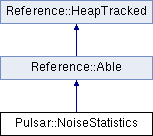 PSRCHIVE
PSRCHIVE
| Ask a Question | Search PSRCHIVE: |
 PSRCHIVE
PSRCHIVE
| Ask a Question | Search PSRCHIVE: |
 Home Home
|
Pulsar::NoiseStatistics Class Reference Computes the noise to Fourier noise ratio. More...
Inheritance diagram for Pulsar::NoiseStatistics:

Detailed DescriptionComputes the noise to Fourier noise ratio. By Parseval's Theorem, the energy in the noise of the off-pulse baseline in the phase domain should be equal to the energy in the noise of the post-Nyquist harmonics in the frequency domain. However, if the profile baseline is corrupted by some periodic structure, then the r.m.s. computed in the phase domain will be larger than that in the frequency domain, where the periodic corruption is likely isolated in some low harmonic. Likewise, if the profile is unresolved, then the r.m.s. computed in the frequency domain will be larger than that in the phase domain because there are no post-Nyquist harmonics. The noise to Fourier noise ratio is a way to detect either of these problems. If it is much greater than unity, then there is likely some low frequency structure in the profile baseline. If it is much less than unity, then it is likely that the profile contains unresolved structure. In either case, there is likely a good reason to discard the data. Member Function Documentation◆ set_baseline_time()
Set the fractional number of phase bins used to calculate noise. Set the fractional number of high frequencies used to calculate noise. Referenced by Pulsar::Statistics::get_nfnr(). The documentation for this class was generated from the following files:
Generated using doxygen 1.14.0
|
||||||||||||||||||||||||||||||||||||||||||||||||||||||||||||||||||||